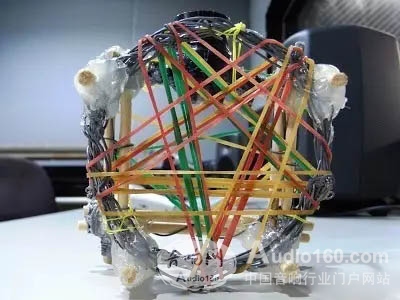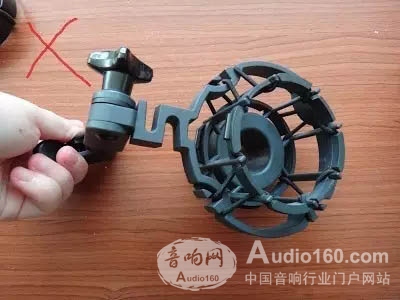The microphone suspension frame (hereinafter referred to as the shock absorber) is just like 'shocking', so don't you have to worry about the earthquake? Of course not pressure! Let me introduce you through the following instructions & pictures! First of all, the shock absorber is a microphone carrier. The microphone should be fixed or locked on the shock absorber in different ways, such as knobs, iron, screws, rubber bands, etc., so that the microphone will not loosen or fall. If you just want to fix it, why not tie the rubber band directly or stick it? (In fact, it's okay! It's just a little scary in appearance.) What's special about the shock mount? (DIY homemade, even if you are not visually dominant, don't dare to use it)? Â Careful observation, almost every type of shock absorber design, there will be elastic material such as rubber cord or rubber band, wrapped around the metal or plastic structure, and the so-called shock ''shock'' It refers to the vibration caused by all the microphones (microphone rack vibration conduction) itself during recording. The main reason for preventing these vibrations is to avoid the vibration conduction and collision sounds of the radio, which affects the quality of the radio. Most of the studio's condenser microphones are so sensitive that they can record the sound of a needle falling off the floor. Therefore, if there is no shock absorber, it is conceivable that the microphone collides with the external force of the microphone stand and the ground is on the ground. The low-frequency vibrations felt by the vibration conduction will appear in your soundtrack from time to time, causing unnecessary vibrations of ''touching''. After understanding the purpose of the suspension frame, there are several tips for using the suspension frame: First, the elastic rubber of the structure of the microphone suspension frame can not withstand excessive pulling of the external force, because the main purpose of its design is not to use ''bearing'', the following example of the shock absorber is correctly taken and placed. Second, 99% of the microphones sold in the market are shipped with the shock absorbers tailored for the microphone. Most of the shock absorbers are similar in their performance, unless you have a special shock absorber. Brand, if you can safely use the original shock absorber, you don't have to buy a brand of products for advertising. Third, unless you have a good understanding of the operating principle, elastic modulus and material of the suspension frame, it is strongly recommended that you do not change the elastic rubber tightness and overall structure of the suspension frame; the suspension frame has a certain degree of mechanical consideration in design. In order to avoid affecting the radio effect or permanently damage the function of the shock absorber (the original shock absorber price is not high, most of the US dollars tens to hundreds of dollars also do not include tariff freight - but the cost may be found for 10 dollars), so thousands Don't try it easily. (This shock mount is very special, there is a safety lock too!) Fourth, under normal usage habits, the life of the suspension frame is equivalent to that of a microphone. Unlike a vacuum tube, there is a significant loss of life and deterioration of sound quality. Therefore, unless your microphone brand has a crisis of production suspension or closure, it will not Need to deliberately smash such objects. Fifth, what is the first time to mount the microphone on the shock mount and then mount it on the microphone stand? Or do you install the shock absorber on the microphone stand before installing the microphone? Imagine, if it is the former, should the microphone be equipped with a shock absorber or a microphone after it is attached to the shock absorber? That's right, no matter what part you take, it will inevitably pull more or less elastic rubber in the process of connecting to the microphone holder. Although the degree of pulling is not the same according to the degree of care of everyone, it is recommended. You can install the shock absorber on the microphone stand before installing the microphone; a small number of microphones are recommended to be installed by two people, so that the damage or risk to the microphone or elastic rubber can be minimized (if not Be careful with the hand slip and there is another person to join the rescue)! The attitude of installing the shock mount and the microphone should not and should not be discounted due to the level of the microphone. This is a kind of cherish and cherish the equipment; the recording project can be intuitively thought of as a concept of radio, but behind it. Every piece of equipment, process and operation advice is a set of standards that have been accumulated by many engineers for many years of research and development, so there is definitely enough credibility and practical effect. Non-Shielded Control Cable YY CVV LIYY
Low Voltage Control Cables
Standard applied: IEC60227, BS 6500
Rated Voltage: 300/500V 450/750V 0.6/1kV
Others: Fire Cable and other property Low Voltage Power Cable can be available
Applications: Those Control Cables are suitable for fixed installations as connection and inter-connection cables in general machine,production lines.
Non-Shielded Control Cable Yy Cvv Liyy,Non-Shielded Control Cable Yy,Non-Shielded Control Cable Cvv,Non-Shielded Control Cable Liyy Shenzhen Bendakang Cables Holding Co., Ltd , https://www.bdkcables.com





